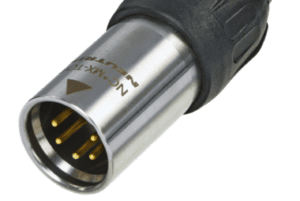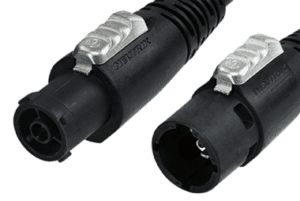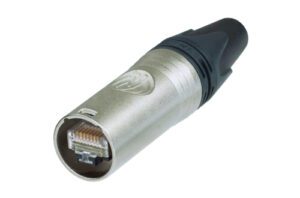Connectors in Concert
Specialty audio connector types each play a different role in creating a full sound. Learn more about the reliable standards and the new connectors that make live entertainment possible.

To be human is to be entertained. It is a necessity, not a luxury. And so, with some Covid protocols in place, live events are back. Concert tours are hitting the road, in some cases after a two-year absence. Venues ranging from auditoriums and sheds to Broadway and stadiums are packed. Audiences and performers alike are reveling in the return to some degree of normalcy. Stage rigging, including a complex array of precision audio connectors, are a critical part of the music experience.
Audio
At a concert, microphones pick up the sounds of the instruments and vocalists. Precision audio connectors play a role too. By convention, 3-pole male XLR connectors (developed by Cannon in the 1950s) are gendered such that male outputs connect to female inputs. In this way, a male XLR microphone output connects to a female XLR cable end. On the other end of the cable, a male XLR cable connector plugs into the female XLR input of either a mixing console or an intermediary stage box. This male-to-female signal flow allows cables to be chained directly together if necessary to extend cable lengths, though doing so loses some of the noise-canceling benefit of the shielded twisted-pair cabling inside the microphone cables.
Miniature XLR connectors are often used in conjunction with wearable, wireless belt packs for in-ear monitoring and/or discreet, head-worn microphones. Switchcraft pioneered the category with its Tini-QG connectors. Various manufacturers offer them, such as Rean’s tiny XLR range.
The support staff at the show (often called “roadies”) communicates over intercom headsets that are wired into wireless belt packs using 5- or 6-pole XLRs. The additional XLR contacts allow the wearer to speak over the headset microphone as well as to switch between different audio sources.
Not all live-event audio connectors use male-to-female gendering. ¼” A-gauge plugs and jacks connect electric and electronic instruments (guitars, keyboards, etc.) to their amplifiers and various effects devices (reverberators, equalizers, etc.). Twist-lock speakON® connectors (developed by Neutrik but offered by a variety of manufacturers under different names) connect the high-amperage outputs of audio amplifiers to loudspeakers.
Lighting and other visual effects
On Broadway and in other fixed-installation theaters, Stagepin connectors (also called “2P&G” or “Bates” connectors) have been a staple for traditional, fixed-position lighting fixtures for over 100 years. Newer lights, lasers, confetti cannons, and other visual effect devices that rotate on one or more axes require connectors that lock in place to withstand the motion and vibration. powerCON connectors, in both powerCON 20 A (blue and gray) and powerCON TRUE1 TOP varieties (also developed by Neutrik), provide AC power to these “smart” theatrical devices.
Again, XLR connectors are used, in this case to transport digital signals to the devices which are networked together so their actions can be synchronized to produce large-scale visual effects. 5-pole XLRs are specified for this synchronization, though 3-pole XLRs are sometimes used as well. Gendering is female out to male in — the opposite of audio gendering.
Image magnification and moving images
Not that long ago, broadcast cameras connected with BNC copper connectors, SMPTE (developed by LEMO Connectors), or opticalCON fiber optic connectors (developed by Neutrik) were focused on performers, with the resulting images projected onto large film-style screens for audiences to enjoy. Today, projectors and passive screens have largely been replaced by LED video walls. Giant LED walls are built up from scores of smaller video tiles which are generally only a couple of feet long. An external processing unit divides and distributes the complete display image so that each tile receives and outputs only its appropriate fragment. Each tile receives power via powerCON and receives its video signal either via an RJ45-style connection (most often etherCON, which encapsulates standard RJ45 connectors within a latch-locking metal housing) or, for very large-scale deployments, a fiber-optic connection such as opticalCON.
IEC / UL 62368-1 points the way towards convergence
While modern live-event video is IP routed by default, audio and lighting are older technologies that predate the IT revolution. But audio and lighting are being brought into the 21st century with a variety of IP-routed consoles, stage boxes, and other digitization tools that bring the cost advantages and functionality benefits of switched networks to live entertainment.
As an example, it was once the case that an expensive transformer split was required for each microphone signal. This would allow the signal to be routed to the front of house position (to be mixed for the audience to hear); to the monitor mixer (who would ensure that the performers could hear properly); and sometimes also to a multitrack recorder. Today, those same microphone signals can be digitized easily and inexpensively at the side of the stage, after which they can be freely duplicated and distributed. This eliminates the need for transformers and bulky, single-signal cables (or “snake” cables consisting of bundles of twisted pair cables, each one dedicated to only one discrete analog signal). With modern digitization, dozens of audio signals can be transmitted bi-directionally over a single category cable or duplex fiber optic cable, substantially reducing the number of XLR connectors required. Similarly, power amplifiers have gotten “smart”: they can receive digital signals telling them not only the audio signal to amplify but also at what level and with what timed delay, equalization, and other features required for optimal sound reinforcement.
In recognition of this convergence of audio-video equipment with information technology, the IEC/UL 62368-1 safety standard was created to merge and replace the formerly separate standards IEC 60065 (for AV equipment like mixing consoles) and IEC 60950-1 (for IT equipment like routers and switches). Within the new standard, AV and IT are treated as one — as they should be.
Today, copper solutions like category cabling connectorized to etherCON Cat 5 and Cat 6A — and multimode and single mode fiber optic cables terminated with MIL-DTL-83526, FIBERFOX, and other rugged interconnects — are being used to network together either the components of each of the individual domains of the live entertainment space (the audio, the visual effects, or the video) or, in the most far-reaching of these technologies, all of those domains together within a single, unified, switched ecosystem. These networking innovations are almost (but not quite) as exciting to the technicians responsible for putting on the show as the talent is to the audience.
To learn more about precision interconnects for live entertainment, visit Neutrik.
Like this article? Check out our other articles on Circular Connectors, Fiber Optic connectors, our Consumer Market Page, and our 2022 Article Archive.
Subscribe to our weekly e-newsletters, follow us on LinkedIn, Twitter, and Facebook, and check out our eBook archives for more applicable, expert-informed connectivity content.
- Connectors in Concert - August 2, 2022
- Analog and Digital Signal Connectors Used in Professional AV - June 29, 2021





